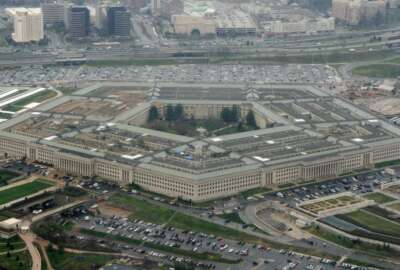Hubbard Radio Washington DC, LLC. All rights reserved. This website is not intended for users located within the European Economic Area.
OMB sees 2022 as ‘most significant year’ for security clearance reform
After digging out of a massive backlog of background investigations, agencies are walking a tightrope to modernize a decades-old process.
The White House is eyeing 2022 as a major year for instituting personnel vetting reform policies, as officials turn their attention toward overcoming longstanding issues with a security clearance process still viewed as too complex and protracted.
After digging out of a massive backlog of background investigations that sent the time it takes to process security clearances skyrocketing, agencies are now modernizing the decades-old process through the “Trusted Workforce 2.0” initiative.
Jason Miller, deputy director for management at the White House Office of Management and Budget, said personnel vetting reform is central to the Biden administration’s priority on strengthening and empowering the federal workforce. Miller oversees the reforms as chairman of the Security, Suitability and Credentialing Performance Accountability Council (PAC).
“We have made meaningful progress, but this year is the year we need to drive it forward,” Miller said during a March 1 event in Washington organized by the Intelligence and National Security Alliance. “2022 is the most significant, most consequential year for personnel vetting reform. That’s how we’re approaching it.”
Last January, the Trump administration published a Federal Personnel Vetting Core Doctrine that serves as the foundation of the Trusted Workforce 2.0 reforms. The document lays out principles for shifting vetting processes “to promote mobility, improve efficiencies and move towards an enhanced risk management approach.”
The Biden administration has carried the initiative forward, with new policies projected to come out shortly.
The PAC expects to finish a “Trusted Workforce 2.0 Implementation Strategy” this spring to serve as a roadmap and guide agency-specific actions, according to a fiscal year 2022 first quarter update from the council.
The Office of Personnel Management and the Office of the Director of National Intelligence are also finalizing new investigative standards to consolidate the existing five investigative tiers into just three, according to the update.
The update shows the council wants to coordinate policy developments and the rollout of new technologies to fully realize Trusted Workforce 2.0 by FY 24.
“That’s why I refer to it as careful choreography,” Miller said. “Any one little piece moving out of line means our entire, end-to-end, soup to nuts reform will fall behind schedule.”
Timeliness progress levels out
The PAC’s first quarter update shows government-wide progress on timeliness leveled out last year after seeing steep improvements in FY 20.
In the fourth quarter of FY 21, the fastest 90% of initial secret clearances took an average of 79 days to initiate, investigate and adjudicate, five days slower on-average than the first quarter of FY 21. The government-wide goal for processing initial secret clearances is 74 days to reach a decision.
Meanwhile, the fastest 90% of initial top-secret clearances took 176 days on-average to process end-to-end in the fourth quarter of FY 21, 35 days slower on-average than the first quarter. The goal for initial top secret clearances is 114 days.
The numbers are a stark improvement from when the background investigations backlog was at its highest in 2019, but reflect how new applicants to national security positions can still expect to wait weeks and months for a decision on their clearance.
“We can’t have something that takes six months or kids that are getting out of school are going to go work for a commercial company,” Carey Smith, president and chief operating officer at the Parsons Corporation, said during the INSA event.
Miller said the true numbers are worse considering the reported data only uses the fastest 90% of cases.
“When you have a million per year, that means 100,000 aren’t actually captured in the numbers that we’re reporting today,” he said. “So we’re going to be moving towards a measurement system that is measuring all.”
He also pointed out agencies can grant interim clearances to applicants awaiting a final decision.
“We also need to be looking at what is actually the timeline to getting people serving mission with interim clearances, not just a process that gets you your final clearance,” Miller said. “The problem that we’re talking through is, how do I get people serving the mission, serving the program on the contracts? Those are things that we’re not fully measuring and reporting today.”
The government hopes to speed up the process by using “continuous vetting,” a system of automated records checks, to augment traditional investigations. Under Trusted Workforce 2.0, agencies also plan to phase out the requirement for a periodic reinvestigation by placing personnel under the continuous vetting system instead.
Already, all 3.6 million clearance holders with the Defense Department are enrolled in an initial version of continuous vetting that defers the requirement for a periodic reinvestigation.
“We have a process where we’re measuring end to end between when you enter the system, and when you get your clearance on the back end,” Miller said. “We need to re-engineer that process. We need to use technology to do it, so that we’re running checks on the front end in real time with data analytics and AI, that actually get butts in seats.”
Reciprocity challenges remain
A long-running issue with the clearance process continues to be the willingness of a one agency to accept a security clearance determination from another.
“We still have got a long way to go on reciprocity,” Senate Select Committee on Intelligence Chairman Mark Warner (D-Va.) said. “Our friends in the intel community are still probably the slowest to accept clearances from other parts of the community.”
A 2019 INSA study found the government is losing talent, productivity and taxpayer dollars as agencies take months to re-investigate individuals who have already been cleared.
It’s a major issue for industry, where companies often want to move personnel between contracts from different programs and agencies. The INSA study reported the delays could total as many as 1,000 lost contractor labor-years and $2 billion a year.
“There’s also a lack of information sharing across the agencies, which hurts,” Smith said. “We probably run about 30 to 60 days for reciprocity processing. But we’ve gone as high as a year-and-a-half to two years.”
Warner supports the idea of establishing timeliness goals for reciprocity, like the goals that are in place for processing initial clearances.
“I think we need similar type goals around reciprocity,” he said. “There may be certain special things with certain intel agencies, but the notion that you’ve got to duplicate the whole process all over, even if it came from a DHS clearance or Energy clearance, when you get to the intel world? No. We just have to grind that down.”
Warner also backed a longstanding industry proposal that would allow the government to share “derogatory information” it knows about individuals that is relevant to the security clearance process with their prospective private sector employer.
“I get that that raises issues of privacy and other things,” he said. “We have to do this thoughtfully, and I would welcome input on how we do that. But I think that’s probably going to be something that’s done in legislation, rather than policy based.”
NBIS the ‘long pole in the tent’
The long-term vision for speeding up the process and sharing data more easily largely rests on the successful development of the National Background Investigation Services (NBIS) system. NBIS is intended to replace legacy background investigation systems with enterprise IT system for end-to-end clearance processing.
NBIS will feature the continuous vetting systems and other automated features.
“That is our long pole in the tent,” Miller said of NBIS. “That is our ability to move from nine different systems that are all different in their approach, paper-based processes, to moving the ball forward.”
The Defense Counterintelligence and Security Agency is overseeing the development of NBIS. The system has faced delays, and DCSA reset the scheduled rollout of NBIS in 2020. The program successfully deployed multiple releases in 2021 after the reset.
Last year, DCSA also initiated onboarding into the system. Along with DCSA, the Air Force, the Smithsonian Institution and the Treasury Department are among the first four agencies to have personnel in NBIS, according to the PAC’s first quarter update.
But NBIS is not expected to reach full operational capability until FY 23, making this a year particularly important one for the system’s development. Peraton is the prime contractor on the NBIS development.
“We are in a better place,” Miller said. “We’re also keeping a very close eye on where we are with regards to NBIS progress, both the deployments as well as the ongoing onboarding.”
Copyright © 2024 Federal News Network. All rights reserved. This website is not intended for users located within the European Economic Area.
Justin Doubleday
Justin Doubleday covers cybersecurity, homeland security and the intelligence community for Federal News Network.
Follow @jdoubledayWFED
Related Stories
Related Topics
Agency Oversight
All News
background investigation
Defense
Defense Counterintelligence and Security Agency
Defense News
Jason Miller
Management
Mark Warner
National Background Investigation Services
Performance Accountability Council
personnel security clearances
security clearance backlog
security clearance reform
Trusted Workforce 2.0
Workforce





